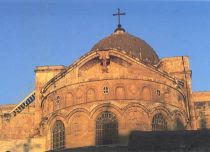According to Christian tradition, many of the events in Jesus’s life and ministry took place in the Holy City. The Last Supper, referring to the final meal shared by Jesus with his disciples before his death, is believed to have taken place in the “Upper Room”or Coenaculum, on the second floor of a building over King David’s tomb on Mount Zion. The Garden of Gethsemane — according to the New Testament, the place where Jesus suffered for the sins of the world the night before he was crucified — is located at the bottom of the Mount of Olives in Jerusalem. On the Mount of Olives is the Shrine of the Ascension, where Jesus is believed to have ascended to heaven. (It is now run by Muslims and a dome covers the structure.) The Church of the Holy Sepulchre, built by Constantine the Great to mark the site of the Resurrection, stands within the walls of the Old City. The remains of Golgotha, the hill upon which Jesus was crucified, is believed to lie inside the church. The church houses priests from the Roman Catholic Church and from numerous Eastern Orthodox traditions. The Via Dolorosa, or “Way of Sorrows,” leading to the Church of the Holy Sepulchre, is the traditional path taken by Christians pilgrims to symbolically relive the events of Jesus’ passion. Because of Jesus’s historical connection to these and other locations, Jerusalem is venerated by Christians throughout the world.

Church of the Holy Sepulchre

